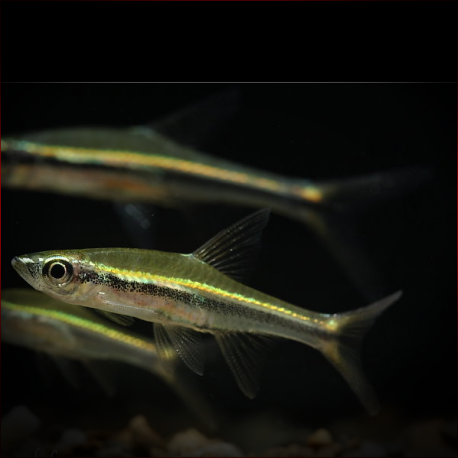More info
Datasheet
| Minimum Tank Size | 90 litres / 23.78 US gallons |
| Maximum Size | 5.5cm / 2.17inches |
| Temperature | 21°C / 69.80°F - 26°C / 78.80°F |
| Hardness | 0.00dgH / 0ppm - 10.03dgH / 179ppm |
| pH | 4.0-7.0 |
General Description
Trigonopoma Gracile, commonly known as the Rasbora gracilis, belongs to the Cyprinidae family under the order Cypriniformes. This species showcases various color forms based on their collection location, exhibiting differences like intense pigmentation in fins or an additional reddish lateral stripe.
Aquarium Setup
For an optimal aquarium setup for the Trigonopoma Gracile:
- Tank Size: A minimum tank size of 90 litres is recommended.
- Decoration: Preferably a heavily planted tank with a dark substrate and wood roots to create shaded spots and caves.
- Additional Elements: Adding dried leaf litter would enhance the natural environment, aiding in the growth of beneficial microbe colonies.
(See table for specific water conditions)
Behaviour
This species is best suited in a peaceful community of Southeast Asian fishes, alongside comparably-sized cyprinids, small loaches, and certain anabantoids. Boisterous or very vigorous tank mates should be avoided as they may outcompete the Trigonopoma Gracile for food.
Feeding and Diet
Trigonopoma Gracile is likely a micropredator, feeding on small insects, worms, crustaceans, and zooplankton in the wild. In captivity, they readily accept small live and frozen foods like bloodworms, Daphnia, and Artemia, along with high-quality dried flakes and granules.
Reproduction & Dimorphism
The reproductive behavior of Trigonopoma Gracile is possibly unrecorded; however, mature females are distinguished by their rounder bellies and slightly larger size compared to the slimmer and more intensely patterned males.
Habitat and Distribution
Primarily found in blackwater streams and rivers of ancient forest peat swamps, Trigonopoma Gracile inhabits regions with low light penetration and dark-stained water due to decaying organic material. Its distribution spans Peninsular Malaysia, Singapore, and the Greater Sunda Islands of Borneo and Sumatra.

